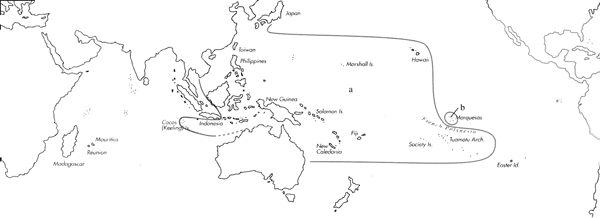
Skip Navigation Links
View access keys for this site.

Range: C. p. pulicarius: Central and W. Pacific, Polynesia except Marquesas; Indian O., Cocos (Keeling) Island, and northern Western Australia; C. p. vautieri: Marquesas.
Description: Medium-sized to moderately large, solid to heavy. Last whorl conical, conoid-cylindrical, or ventricosely conical, often broadly conical in C. p. pulicarius; outline convex at subshoulder area and almost straight below, often with slight convexity above base. Siphonal fasciole pronounced, may be separated from basal part by an incision. Shoulder subangulate to rounded, weakly to strongly tuberculate. Spire of low to moderate height, consistently low in C. p. vautieri; outline slightly concave to straight. Larval shell of about 3.5 whorls, maximum diameter about 0.7 mm. Postnuclear spire whorls strongly tuberculate. Teleoconch sutural ramps concave, with 1 increasing to 4-5 spiral grooves. Last whorl with variably spaced spiral grooves and adjacent ribs on basal fourth.
| Shell Morphometry | ||
|---|---|---|
| L | 35-75 mm | |
| RW | 0.29-1.10 g/mm | |
| (L 35-64 mm) | ||
| RD | 0.63-0.80 | |
| PMD | 0.78-0.88 | |
| RSH | 0.04-0.22 | |
C. p. pulicarius (Pl. 11, Figs. 8-12): Ground colour white. Last whorl with spiral rows of irregularly set black spots or bars clustered in an interrupted spiral band within adapical and abapical third; clusters often emphasized by underlying shadows of yellow, brown or violet. Near base, white dashes usually alternate with black markings. Black spots and bars may fuse into solid axial flames. Larval whorls white to grey. Teleoconch sutural ramps with variously solid black markings, varying in number and arrangement. Aperture white to bluish white, often suffused with yellow or orange.
Periostracum of subadults yellow, thin and translucent in Hawaii, fawn-coloured in Fiji; adult periostracum reddish brown, thicker and almost opaque in Hawaii, Fiji and Cook Islands; adults from Guam and northern Queensland with a yellowish olive, translucent, velvety periostracum bearing interlaced axial threads.
C. p. vautieri (Pl. 11, Figs. 13, 14) with brownish grey ground colour and reddish brown pattern; bands around last whorl underlaid with reddish brown; intermittent white dashes often pronounced also adapically; aperture white. At Hansa Bay (N. New Guinea), dorsum of foot ivory, suffused with cream and grey or sometimes with pink and green; median zone edged with pale tan dots on posterior half or completely dotted; anterior part bears a black central blotch with 2 backward- pointing lines of black dots, and its distal edge is occasionally white. Sole of foot ivory, washed with tan. Rostrum olive-grey or pale tan. Tentacles pale yellow. Siphon may be white, tipped with orange and washed with brown proximally on dorsal side, with a black half-ring anterior to centre, or siphon may match foot in colouration, with white dots distally and tan dots proximally (Pl. 74, Figs. 21,22; Pl. 78, Fourth row, left) (Chaberman, pers. comm., 1981 ). In Hawaii, foot and rostrum pale tan, mottled with yellowish to reddish brown; tip of siphon reddish orange, followed by pale buff and black bands (Kohn, 1959a).
Radular teeth stout, with an adapical barb opposite a large second barb or a blade; serration short, terminating in a cusp; base with a spur (Troschel, 1868; James, 1980).
Habitat and Habits: : Intertidal to more than 75 m; in deep sand away from limestone outcrops and growing coral; mostly in sand-filled channels and large patches of sand on reef flats and in bays. Reported to be both active only at night and active during the whole day (Cernohorsky, 1964, 1978; Kohn 1959a,b; 1980a; Thorsson, 1989; Tirard, pers. comm., 1989). C. pulicarius feeds on polychaetes (mainly Capitellidae, occasionally also on Nereidae and Eunicidae); in Hawaii, echiurans ("spoonworms") are known to be apart of the diet. Venom toxic to worms but neither to molluscs nor to fishes (Kohn 1959b, 1980a; Endean & Rudkin, 1965). Egg capsules with crenulate margins; capsules measure 18-19 x 14-15 mm in Hawaii, 13-14 x 15.8-17.5 at Lizard Id. (Australia) and 8-9 x 10-11 mm at Enewetok, Marshall Is. Egg diameter of 150- 175 ┬Ąm predicts a minimum pelagic period of about 27-26 days (Huish, 1978; Perron, 1981b; Perron & Kohn, 1985; Kohn & Perron, 1994).
Discussion: C. pulicarius resembles C. arenatus in shell characters and body colouration. The pattern of the latter species consists of more and smaller spots that form flamelike clusters but do not fuse into solid axial flames; its last whorl has a more convex outline as well as weaker spiral sculpture, and tends to be ventricosely conical but not conoid-cylindrical. C. fustigatus and C. punctulatus refer to C. p. pulicarius. The local race from the Marquesas Is. was described as C. vautieri, but the conchological similarities support its status as a geographic subspecies of C. pulicarius.

C. pulicarius Range Map (a: C. pulicarius pulicarius b: C. pulicarius vautieri)
This section contains verbatim reproductions of the accounts of 316 species of Conus from the Indo-Pacific region, from Manual of the Living Conidae, by R÷ckel, Korn and Kohn (1995). They are reproduced with the kind permission of the present publisher, Conchbooks.
All plates and figures referred to in the text are also in R÷ckel, Korn & Kohn, 1995. Manual of the Living Conidae Vol. 1: Indo-Pacific Region.
The range maps have been modified so that each species account has it own map, rather than one map that showed the ranges of several species in the original work. This was necessary because each species account is on a separate page on the website and not confined to the order of accounts in the book.
Return to framed version (returns to search page)